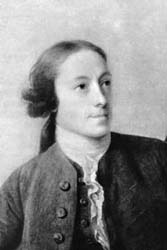Strawberry Hill
The creation of Horace Walpole
built 1698 - present


Walpole builds his 'little Gothic Castle' - Strawberry HillWalpole acquired the remainder of the lease from Mrs Chenevix in 1747, buying the property the following year. Discovering that it came with a piece of land known as Strawberry Hill Shot he christened the house Strawberry Hill. The hill is unremarkable although strawberries are known to have been grown in Twickenham and Isleworth before that time.
Horace Walpole (1717-1797) was born in London, the youngest son of the Prime Minister, Sir Robert Walpole. He spent some months in Twickenham with Townshend relatives in 1726, but did not settle in Twickenham until later, when he acquired his "little plaything house" from Mrs Chenevix.
Walpole soon made his intentions clear: "I am going to build a little Gothic castle at Strawberry Hill", and he asked his friends for any fragments of old painted glass, armour, or anything.
He spent the rest of his life in this pursuit, in writing gossipy waspish letters, histories, and founding a printing press there in 1757. His gothic novel, "The Castle of Otranto" was not printed at Strawberry Hill, being published anonymously in London in 1764.
Late in life he inherited the title given first to his father and, following the deaths of his elder brothers, became the 4th Earl of Orford. By this time he had increased the five acre property to an estate of 46 acres.Property passes to Waldegrave familyWalpole left a life tenancy of Strawberry Hill to the daughter of his great friend and cousin, Henry Seymour Conway. That daughter, Mrs Anne Seymour Damer, was a well-known sculptress. But finding the costs of maintenance too great, she passed the property over to Walpole's great niece, Laura Countess of Waldegrave and moved to York House, Twickenham.
Laura died in 1816 and the property passed to her son, the 6th Earl. He had married an army chaplain's daughter, after she had borne him a son. Shortly afterwards she bore him a legitimate son. In June 1816 the baby, George, was baptised in St Mary's Church; this was immediately followed by a second marriage ceremony for the Earl and his wife.

Handsome and wild
The Earl died in 1835 and George inherited the title. His elder brother, John, in 1839 married Frances Braham, daughter of a well known singer, John Braham. Both the brothers were handsome but wild. John was an epileptic, and died early.
George, the younger brother but legitimate, then married Frances (his brother's widow) in Scotland in September 1840, thus avoiding the prohibitions of the Marriage Act of 1835.
The Earl, however, was already in trouble with the police, and in 1841 was committed to Newgate prison for 6 months "for riotous behaviour". He had assaulted a policeman in Kingston, the worse for drink, and was committed to the Assizes by the Twickenham Bench. In prison, Frances joined him in a comfortable apartment with servants aplenty. They returned to Strawberry Hill in November 1841.
The 'Great Sale'of 1842
The Earl, pressed by debts and out of sympathy with Twickenham, then decided to sell off the Walpole treasures and to abandon the house. 'The Great Sale' of 1842 lasted for 32 days in all, starting on 25 April 1842.
The Strawberry Hill receptions
After travelling abroad the Waldegraves returned to England in 1844, going down to Harptree Court in Somerset. Two years later the Earl died, leaving Strawberry Hill to Frances.
Then, in 1847, she married the elderly Liberal MP, G.G. Harcourt, and became a leading Liberal hostess. In 1855, she decided to restore Strawberry Hill and turned it into a place for the great political receptions of the time. She extended the house, building what is today known as the Waldegrave Drawing Room. In 1861, Granville Harcourt died.
A year later, Lady Waldegrave married her fourth husband, Chichester Fortescue MP, an Irishman, who became Lord Carlingford. The Strawberry Hill receptions reached their zenith, but Lady Waldegrave died in July 1879 aged 58.
Carlingford inherited the estate and put it up for sale in 1882. It was bought by an American Hotel Company with a view to conversion but sold on in 1883 to Baron de Stern. His son, created Lord Michelham in 1905 inherited in 1887 and when he died his widow sold the property to the Catholic Education Council.
St Mary's College
This enabled the transfer of St Mary's College, Brook Green to Strawberry Hill in 1925. Today St Mary's College is a college of the University of Surrey.
Cottage in the woods
Erosion of the estate had started in 1883 with the sale of land for housing in Waldegrave Park. This continued all round the perimeter well into the 20th century.
However, the small "Cottage in the Woods" to which Walpole was reputed to retreat to escape visitors remains, across Waldegrave Road, named Harptree House, after the Waldegrave's Somerset estate.
Further reading:
W S Lewis, Horace Walpole, Rupert Hart-Davis, 1961
Wilmarth Lewis, Collector's Progress, Constable, 1961
W S Lewis, A Guide to the Life of Horace Walpole, Yale, 1973
R W Ketton-Cremer; Horace Walpole, 1964
0.Wyndham Hewett; Strawberry Fair, 1956
John Iddon, Horace Walpole's Strawberry Hill, a History & Guide, 1996
Rev.J.Doyle, Strawberry Hill, 1972, a booklet
Anthony Beckles Willson, Strawberry Hill - A History of the Neighbourhood, 1991
Peter Guillery & Michael Snodin, Strawberry Hill: Building and Site, Architectural History 38, 1995
Twickenham 1600-1900, People and Places, Borough of Twickenham Local History Society Paper No47, 1981




